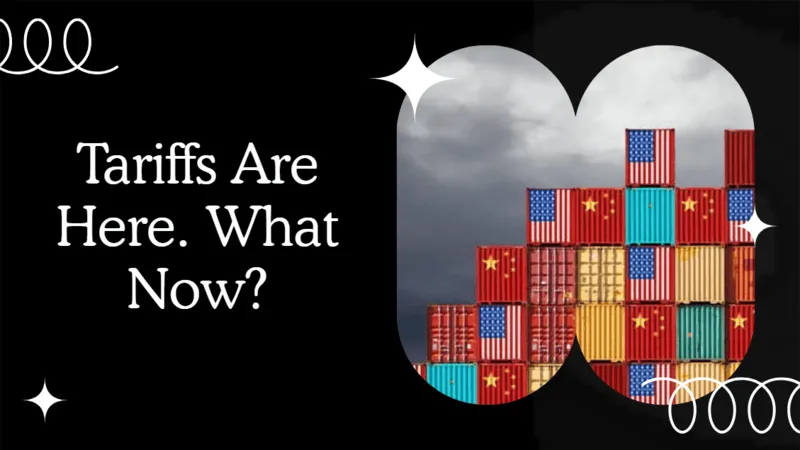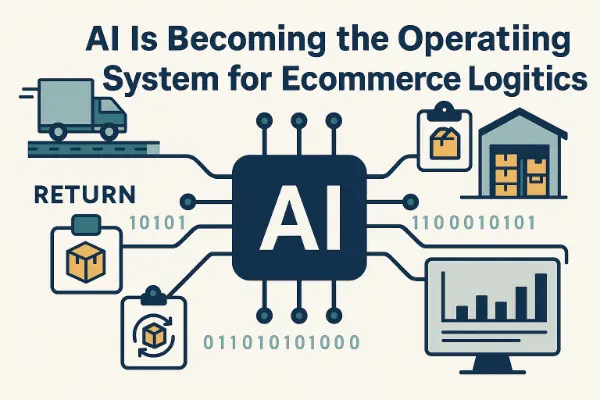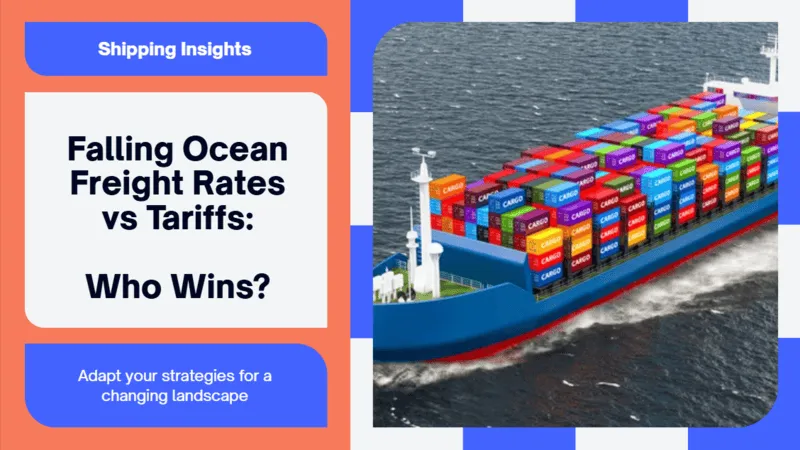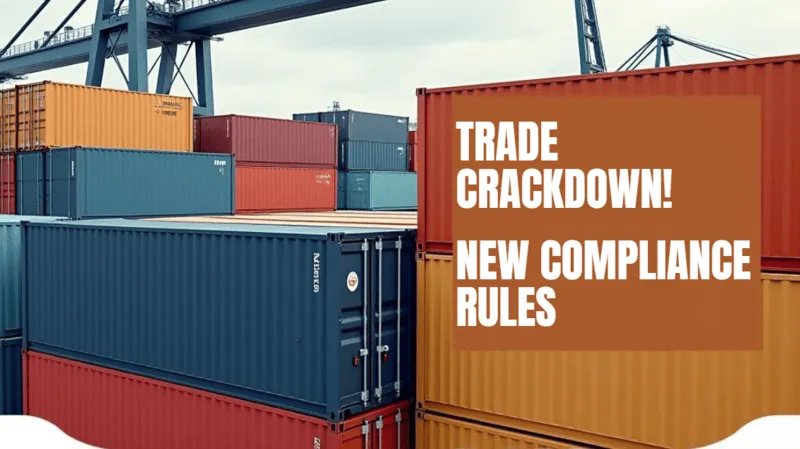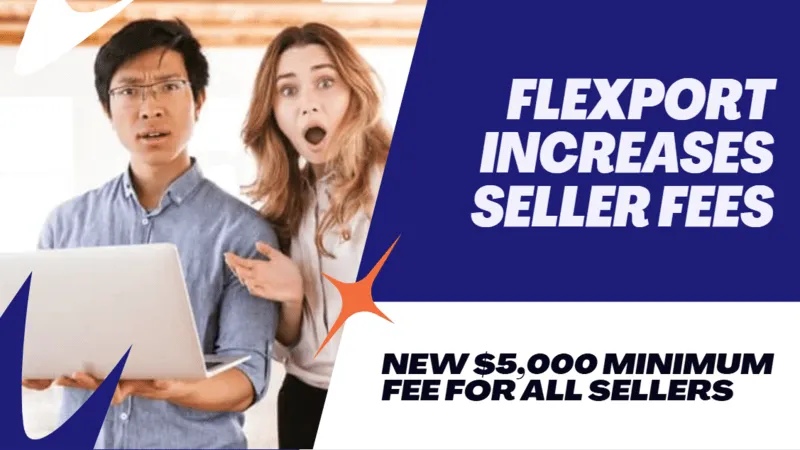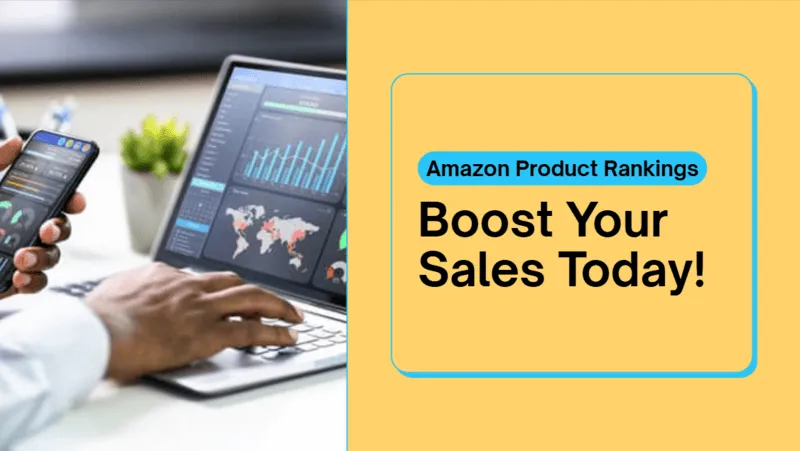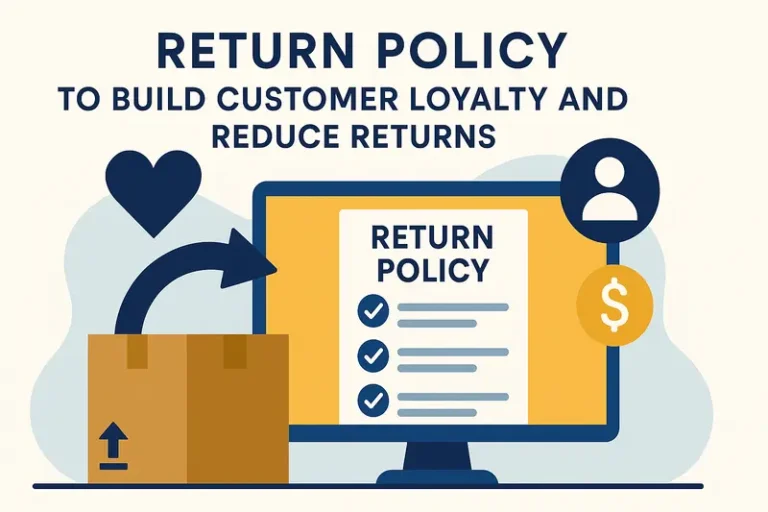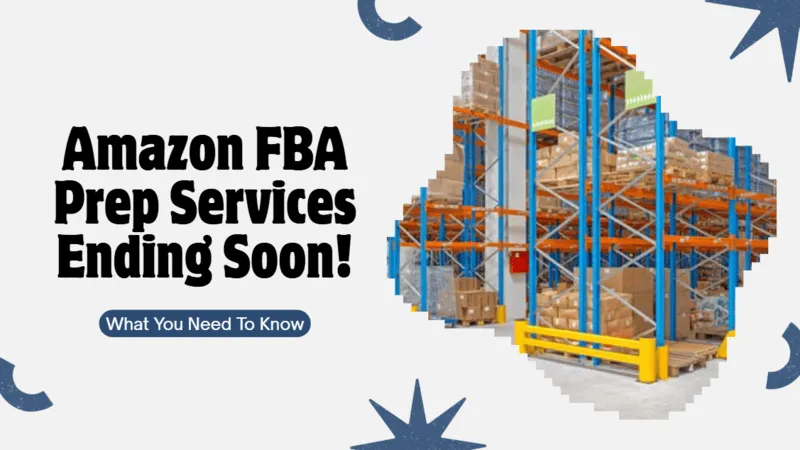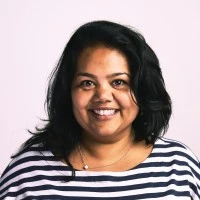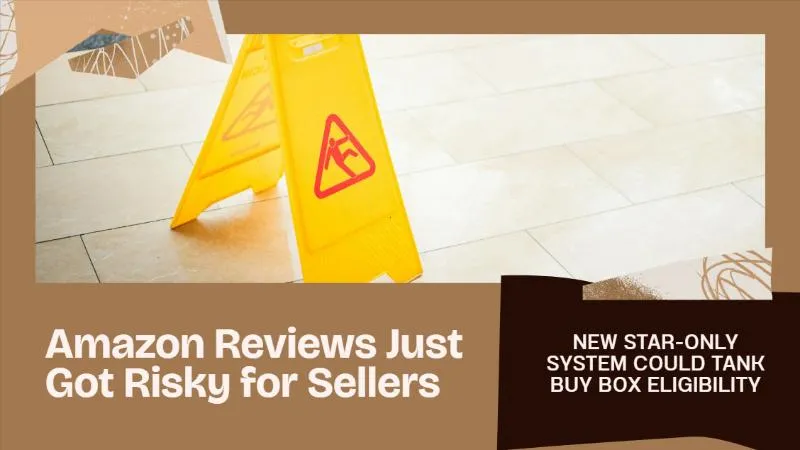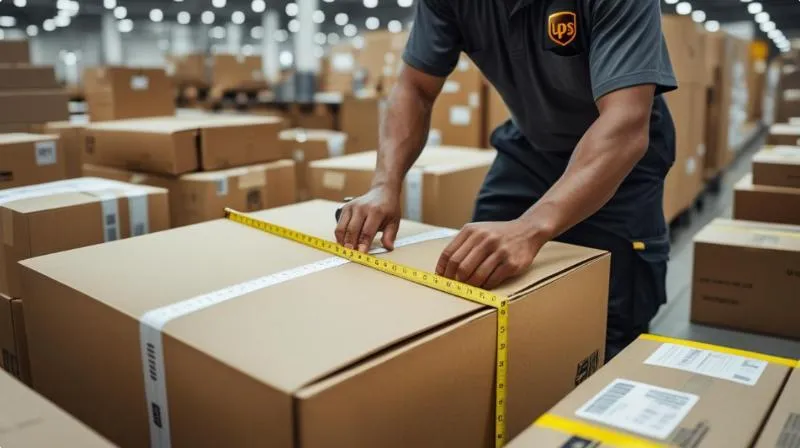Ecommerce Logistics: Tariffs Are Here. Now What? The Tough Logistics Decisions No One Wants to Talk About
In this article
 7 minutes
7 minutes
Tariffs just blew up what we thought was normal in ecommerce logistics. Suddenly, supply chain planning isn’t a spreadsheet; it’s a survival game. If you’re an ecommerce business owner, brand operator, or logistics pro, buckle up. Ecommerce business owners, in particular, are facing new challenges in managing last-mile delivery and logistics management as the landscape shifts.
Man, it’s wild out here. One day, you’re cruising along with tight profit margins, seamless inventory management, and a fulfillment network humming along. The next? Tariffs land like a sucker punch. If you were hoping tariffs were just a maybe, you’re late to the party. They’re here.
Let me break it down, because right now, ecommerce logistics isn’t some nice-to-have optimization. It’s a battlefield.
Tariffs Aren’t Theory, They’re Real, and They’re Biting
Here’s the short version: effective August 2025, the U.S. slapped a patchwork of hefty tariffs across the board, on steel, copper, imports from Canada, Brazil, India, and more, where rates are now soaring up to 50% on sectors like appliances, copper, and consumer goods.
At the same time, the “de minimis” exemption, remember, that $800 threshold letting cheap imports slip through duty-free? It’s gone for good as of August 29. Every single international package now gets taxed or slapped with a flat fee of up to $200.
We’re seeing massive spikes in shipping costs, with shipping costs now a major factor impacted by the new tariffs, along with supply chain disruption and overall logistics operations chaos. The strain on the logistics network is affecting the flow of goods through ports and warehouses. Los Angeles and Long Beach ports shattered records in July, as importers raced to get freight in before the tariff cliff. Distribution centers are playing a critical role in managing the influx of inventory and supporting order fulfillment during these tariff changes.
Slash Your Fulfillment Costs by Up to 30%
Cut shipping expenses by 30% and boost profit with Cahoot's AI-optimized fulfillment services and modern tech —no overheads and no humans required!
I'm Interested in Saving Time and MoneyDo Layoffs and Price Hikes Sound Familiar?
KAVU, like many ecommerce brands, took a defensive posture. They delayed layoffs and held off on raising prices. But when tariffs hit, boom, margins cratered. Inflation isn’t just about the Fed; it’s about logistics bleeding profit through inflated costs, including rising warehousing costs. P&G hiked prices on essentials. Home electronics, veggies, and producer prices are climbing fast.
If you’re just cutting costs in a knee-jerk move, you might stall a little, but you’ll be toast sooner or later. Cost-cutting measures or logistical challenges can also negatively impact service quality, which in turn affects customer experience. You can’t fiscal-austerity your way into resilience.
Here’s the Real Opportunity: Act Proactively
Agility is the new profit lever. That’s where Cahoot steps in, because when boom-time logistics is over, the future is brands that flex fast, automate smarter, and dodge the worst before it hits. Adopting the right logistics strategies is now essential for adapting to tariff changes and maintaining a competitive edge.
Here’s what I’m telling brands:
- Run a tariff-impact audit on your supplier map, SKU by SKU. Tag where your supply chain is vulnerable to 10 %, 30 %, or 50 % duties, and assign risk scores. This is logistics strategy 101 now.
- Diversify or near-shore your sourcing. Stop relying on one region. Mexico, Southeast Asia, and even U.S.-based suppliers reduce landed cost and speed up delivery times and last-mile delivery. And yes, that improves customer experience and customer satisfaction, helping you meet customer expectations and enhancing customer satisfaction.
- Front-load compliant inventory where possible. If bestsellers aren’t tariff-exposed, lock ‘em in before lead times jump. That’s inventory management, efficient order fulfillment, and fulfillment process optimization, turned into a competitive edge.
- Flex fulfillment via Cahoot. Use peer-to-peer fulfillment, multiple fulfillment centers, and automation so you can reroute orders on a dime, optimize delivery routes, and lean on regional carriers when big ones spike. Modern fulfillment centers automate repetitive tasks to improve efficiency and accuracy. That’s shipping automation, modern ecommerce logistics in action. Choosing the right logistics provider is crucial for operational flexibility, and leveraging fulfillment services from an ecommerce logistics partner like Cahoot supports your ability to adapt quickly.
- Experiment with pricing transparency. No one trusts surprise hikes. Say: “Hey, costs are shifting globally, here’s what’s up, here’s how we’re keeping value solid.” That humanizes your ecommerce logistics strategy and protects your brand reputation.
- Simulate three clear scenarios: Full-blown tariff grind (worst case), partial rollback, or legal reversal. The law games are still being played. If you’re not modeling all three, you’re flying blind. Taking proactive action and maintaining agility with the right logistics strategies directly supports business growth and long-term success.
Why This Isn’t Just Another Crisis, It’s a Reset
Let’s get real: the ecommerce supply chain being disrupted is not a fluke. We’re in a reset; modern ecommerce logistics must be dynamic, transparent, enmeshed with automation, not manual firefighting. The logistics process is now a series of integrated activities, including inventory management, warehousing, order processing, shipping, and last-mile delivery, that must be optimized in this new environment. It’s a transformation from reactive to proactive.
Brands that cut costs hastily? Unfortunately, they’ll struggle with warehouse management system inefficiencies, reverse logistics slowdowns, delayed same-day delivery, and ultimately failing customer expectations. Poor decisions can also lead to customer dissatisfaction, especially when it comes to returns and delivery delays. The wrong moves now will haunt you next year.
But brands that lean into agility, optimizing logistics services, building fulfillment networks, smoothing order processing, triaging shipping costs, optimizing delivery routes, and enhancing customers’ doorstep experiences, they’ll emerge stronger and ensure customer satisfaction.
That’s not optimism, that’s the winning logician’s lens. Online businesses that leverage advanced logistics are not just delivering products; you’re delivering confidence, even when trade policy is trying to throw you off.
Looking for a New 3PL? Start with this Free RFP Template
Cut weeks off your selection process. Avoid pitfalls. Get the only 3PL RFP checklist built for ecommerce brands, absolutely free.
Get My Free 3PL RFPEcommerce Logistics, Summed Up
These key concepts encompass the full scope of ecommerce logistics, from managing online orders and inventory to leveraging fulfillment centers and third-party logistics (3PL) providers. As many ecommerce businesses and leading brands scale on major ecommerce platforms, technical expertise and real-time tracking become essential for efficient logistics operations and delivering products to the customer’s doorstep. Commerce logistics also includes inventory management, shipping discounts, and reverse logistics, all of which are critical for online retailers and online stores as the ecommerce business grows.
Quick Tactical Takeaways
- Tariffs are live. No waiting in the wings. The time to act is now.
- Set your logistics partner strategy around automation and flexibility, including selecting the right shipping carrier to optimize delivery speed, costs, and customer satisfaction.
- Diversify supply lanes. Near-shore when you can.
- Use Cahoot to flex fulfillment, re-route fast, and save last-mile margins.
- Lock in inventory smartly, especially non-tariffed SKUs.
- Communicate price shifts clearly with customers. That builds loyalty when supply chain chaos builds frustration.
Frequently Asked Questions
What is ecommerce logistics?
Ecommerce logistics refers to the planning, implementation, and control of the movement and storage of goods for online retail, from the supplier to the customer’s doorstep.
How do tariffs affect ecommerce supply chains?
Tariffs increase landed costs, disrupt established supplier relationships, and can lead to longer delivery times or higher prices for customers.
How can ecommerce businesses adapt to sudden supply chain disruptions?
Brands can diversify sourcing, leverage fulfillment centers in multiple regions, use third-party logistics partners, and optimize delivery routes to maintain cost efficiency and customer satisfaction.
What role does inventory management play in tariff resilience?
Managing inventory strategically, stocking high-margin, non-tariffed goods, and positioning them in regional fulfillment centers helps protect delivery speed and cost efficiency.
Why is agility important in modern ecommerce logistics?
Agility allows ecommerce businesses to pivot quickly when facing supply chain disruptions, meeting customer expectations, and safeguarding profitability.

Turn Returns Into New Revenue
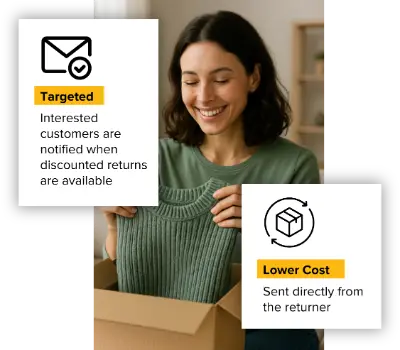
Ocean Freight Trends: Can Falling Rates Offset Tariff Costs? A Strategic Playbook for Brands
In this article
 10 minutes
10 minutes
- Ocean Freight Trends: The Data Speaks
- Why Sellers Should Be Paying Attention (But Few Are)
- Link to the Tariff Pause, and Why It Matters
- How to Act: Your Tactical Playbook
- What to Look for When Choosing Fulfillment Partners Now
- Now vs. Later, You Don’t Get a Mulligan in Q4
- Bringing It Home
- Frequently Asked Questions
Spot ocean freight rates just tumbled more than 50% in 2025. Sounds like a rare win, right? But paired with stubborn tariffs and uneven demand, that dip is a double-edged sword. Recent developments in ocean freight trends, such as shifting capacity and changing rate structures, have contributed to the current market situation and are shaping how businesses should respond. As someone watching orders flow through fulfillment centers every week, I can’t help but think many sellers aren’t fully connecting the dots. This is the time to reconsider your cost structure, not coast through Q4 waiting for luck.
Ocean Freight Trends: The Data Speaks
Let’s look at the numbers. Asia–U.S. spot container rates crashed; status updates from Xeneta and FreightWaves show declines of 62% to the West Coast and 53% to the East Coast since early June. Latest rates hover around $2,100 per FEU to the West, and $3,300 to the East Coast, with the East dropping another 9% since late July. Both freight rate and spot rates are key metrics tracked by shippers to benchmark costs and understand market dynamics. Blank sailings doubled mid-June, but even tight capacity hasn’t reversed the slide. These rate changes reflect ongoing shifts in the supply-demand balance within the ocean freight markets, as carriers adjust to fluctuating demand and available capacity.
By mid-June, transit times weren’t stalling; they were free-falling. Carriers are shuffling boxes via longer routes, like around the Cape of Good Hope, to absorb pricing pressure.
Dig deeper: China import volumes fell due to tariff worries, so demand is softening despite the rate relief. Lower volumes and excess capacity are contributing to the current market environment, putting additional downward pressure on rates. Add projections, U.S. port volume down 5.6% for 2025, and you realize this isn’t just freight dislocation; it’s demand erosion. Available capacity is expected to remain high relative to imports, further impacting the supply-demand balance in the ocean freight markets.
Slash Your Fulfillment Costs by Up to 30%
Cut shipping expenses by 30% and boost profit with Cahoot's AI-optimized fulfillment services and modern tech —no overheads and no humans required!
I'm Interested in Saving Time and MoneyWhy Sellers Should Be Paying Attention (But Few Are)
Here’s where the “a-ha” moment hits: If your business booked inbound freight at $1,000/FEU and now it’s $2,100/FEU, you might breathe easier because there’s a signal: stabilization. But if consumer demand has collapsed, or is delayed by tariffs, lower rates won’t protect your bottom line. You’re not out of the woods; you’re just driving through the forest at a lower cost, with visibility getting worse. Shippers and businesses are directly impacted by these market changes and must adapt their strategies to maintain profitability and resilience in their supply chains.
Buffering with cheaper freight only helps if:
- You’re acting fast, booking new shipments while rates are low.
- You’re reforecasting demand, adjusting import cadence, and not tying February margin to July prices.
- You’re modeling the margin bridge: rate drop vs. tariff impact vs. demand elasticity.
- You’re tracking goods moving: understanding how fluctuations affect your margin and inform supply chain decisions.
One of my Cahoot clients saw a late-June shipment cost drop from $1.8K/FEU to $900, yet they held off buying more. That’s a textbook case of margin deficit induced by indecision. Freight forwarders play a crucial role in helping businesses navigate these supply chain challenges by providing up-to-date logistics data and strategic guidance.
Link to the Tariff Pause, and Why It Matters
The U.S. recently extended the 90-day China tariff pause into November. That’s your window. However, ongoing tariff uncertainty continues to impact planning and supply chain strategies, as shippers remain cautious about future changes in trade policy. If you don’t lock freight now, you risk:
- Missing your rate-low anchor.
- Facing higher inbound pricing if import tariffs on Chinese imports snap back, which could significantly increase your shipping costs.
- Triggering stockouts just before peak, and sprinting to expedite at a loss.
The math is brutal if you’re shipping seasonal inventory or rolling a Q4 promotion lens.
Looking for a New 3PL? Start with this Free RFP Template
Cut weeks off your selection process. Avoid pitfalls. Get the only 3PL RFP checklist built for ecommerce brands, absolutely free.
Get My Free 3PL RFPHow to Act: Your Tactical Playbook
When I talk with sellers and retail partners this week, these are the moves on my checklist:
- Build a margin thermal map
Chart freight vs. cost of goods vs. forecast demand. Feel where the break-even lies. Reference data from the Energy Information Administration for up-to-date market trends and projections. - Stretch the freight decision curve
Lock in contracts on 30 – 60% of shipments now, or sign MOQs with volume flexibility. Avoid total roll-over in an upside-down cost environment. Consider how new alliances among carriers may impact contract terms and operational efficiency. - Geo-optimize shipments
If your freight to the East Coast is cheaper and your orders are West-heavy, consider splitting via rail or an interchange that aligns your supply and demand geography more efficiently. Factor in the role of ports and major ports as key nodes in the logistics network, and assess how vessel and vessels routing decisions can impact transit times and costs. Optimize for trade lanes and transpacific lanes, especially given recent disruptions in the Red Sea and Suez Canal, which have led to longer transit times and increased costs. The Red Sea crisis and Red Sea disruption have forced many vessels to reroute, impacting shipping strategies and capacity. Stay alert to port congestion risks at major ports. - Audit de minimis strategy
With the $800 de minimis exemption gone and flat fees reined in, low-value parcel feeds may not be your safe harbor. Changes to the de minimis exemption can significantly impact import strategies, tariff compliance, and supply chain costs. Check if you’re underpaying attention to how thresholds or fees are shifting. - Connect freight intelligence to fulfillment capacity planning
Lower freight cost? Great. If it shifts inventory timing, make sure your fulfillment nodes are primed; otherwise, you save on freight and bleed margin on holding costs or missed demand. Be aware that longer transit times and capacity changes can affect your planning. - Use carriers’ capacity cues as a demand indicator
Spot rate dips together with blank sailings and looser import bookings suggest either insiders anticipate demand drops, or a surprise spread. Carriers may remove capacity or make capacity changes in response to market signals. Use that as a signal, not just cost. - Plan for peak season and operational risks
Anticipate peak season demand spikes, which often lead to port congestion at major ports. Expect freight rates to fluctuate due to capacity constraints, vessel rerouting, and disruptions in key trade lanes.
Look ahead and stay informed about market changes by following industry experts and best practices from the logistics industry. Monitor developments in the Red Sea, Suez Canal, and other critical routes, as well as the formation of new alliances. Use insights from the Energy Information Administration and other authoritative sources to expect freight rates and plan proactively.
What to Look for When Choosing Fulfillment Partners Now
If your supply chain is shaking, your fulfillment strategy should also flex. When vetting 3PL or network partners for peak or Q1, look for:
- Multi-node agility: Can they bulk store in low-cost zones or bump orders between nodes fast? It’s crucial that fulfillment partners can efficiently handle diverse types of cargo to ensure goods keep moving smoothly.
- Dynamic receiving & stocking: Do they adjust inventory receipt across nodes based on freight timing?
- Visibility integration: Can you see inbound, via ETAs and freight status, to buffer forecasts in your fulfillment platform?
- Flex pricing: Are they set up for cost-tier shifts coming out of transit windows? Note that disruptions can lead to increased insurance premiums, which should be factored in when evaluating fulfillment partners.
Cahoot’s platform, for example, helps brands simulate freight timing into their SLA models, smoothing transit volatility into fulfillment performance predictability. That’s not marketing, I’m telling you what I’ve seen sellers lean into when freight cost takes a surprising turn.
Now vs. Later, You Don’t Get a Mulligan in Q4
If your supply team is in “wait and see” mode, you’d better ask: what’s the downside? You miss cheaper freight now. With the current downward trend in rates, waiting could mean missing out on favorable rate changes that impact your timing decisions. Then:
- You pay more per unit.
- You’re late getting inventory in.
- You risk expedited rush fees stacking on tariff risk.
Monitoring the market and the broader freight market is crucial for making informed, strategic decisions, as trends and capacity shifts can quickly alter the landscape.
Done right, this moment is not a problem; it’s a lever. If you model 10%, 20%, 30% of inbound freight booked now versus way later, the margin outcome is very different.
Scale Faster with the World’s First Peer-to-Peer Fulfillment Network
Tap into a nationwide network of high-performance partner warehouses — expand capacity, cut shipping costs, and reach customers 1–2 days faster.
Explore Fulfillment NetworkBringing It Home
Yes, freight is cheaper, for now. Yes, tariffs are spidering back. But these are signals, not setbacks.
Imagine your CFO sees “freight costs lower,” but you’re still running lean margins. That’s because freight savings never flowed through the P&L, because you didn’t act.
If you treat freight dynamics as passive noise, you’re leaving margin on the table. If you let demand, pricing, and fulfillment sync up to freight cycles, you stabilize your chain and maintain smooth growth.
Takeaways:
- Map freight vs. margin + demand.
- Pre-book now where it helps, but stay agile.
- Gear your fulfillment pick/network to freight timing.
- Don’t let cheap rates become a mirage; make them real.
Your supply chain doesn’t have to echo with uncertainty. Sometimes the offset you need lands when rates fall, just don’t blink.
To stay ahead in the ever-evolving shipping and ocean freight market, it’s crucial to stay informed about industry trends, global trade dynamics, and market forecasts. Stay informed and look ahead to future developments so your business can build resilience and capitalize on opportunities as the industry continues to change.
Frequently Asked Questions
What’s driving the more-than-50% drop in Asia-U.S. freight rates?
Spot container rates have fallen sharply on transpacific lanes due to lower volumes, increased available capacity, and reduced import demand. Carriers have responded with blank sailings and longer routes (like around the Cape) to manage velocity and utilization. These factors have led to significant rate changes, as the supply-demand balance has shifted, especially notable in the past month.
Can cheaper freight actually make up for high tariff costs?
It can, if you act strategically. In the broader freight market, monitoring freight rate trends is crucial for effective planning. Locking in lower rates before tariffs reset and syncing with demand flows can preserve margin, especially as you expect freight rates to change due to market dynamics. Simply waiting isn’t enough; you need active cost modeling and staging, while also considering tariff uncertainty as a key risk factor.
How does the tariff pause affect shipping strategy?
The 90-day China tariff pause creates a window to import at lower freight rates before uncertainty returns. However, ongoing tariff uncertainty and the risk of import tariffs returning mean that brands must carefully monitor trade policy developments. This is especially important for those relying on Chinese imports, as changes in tariffs can significantly impact shipping strategy, freight rates, and supply chain planning. That timing is critical for brands shipping seasonal or promotion-linked stock.
What should sellers do if freight is low but demand is unpredictable?
Use freight models to project margin impact, stagger orders across the pause window, work splits across nodes and geographies where freight varies, and communicate with fulfillment partners about receipts and volume flex. In times of unpredictable demand, resilient supply chains are essential for keeping goods moving efficiently and minimizing disruptions. Freight forwarders play a key role in managing logistics and providing up-to-date information on shipping rates, helping businesses adapt to market fluctuations and make informed decisions.
How can fulfillment requirements change when freight drops?
Falling freight costs might justify higher in-transit inventory or multi-node buffering. But you’ll need fulfillment partners that handle shifting receipts, dynamic stocking, faster stock-turn decisions, flexible network logistics, and diverse cargo types. Additionally, disruptions can lead to increased insurance premiums, impacting overall operational expenses. Looking to the logistics industry for best practices can help your business adapt to changing freight costs and evolving market conditions.

Turn Returns Into New Revenue

“Trade Enforcement” Crackdown: New Rules that Could Kill Your Ecommerce Business
In this article
 11 minutes
11 minutes
- Why The Pressure Is Rising (And Why Ecommerce Feels It First)
- The Five Most Common Potholes I See In 2025 (And How They Escalate)
- What Actually Happens When You’re Flagged (Beyond The Fine Print)
- DDP: Keep It, Fix It, Or Sunset It?
- The Practical Compliance Stack (What High-Performing Merchants Are Already Doing)
- The Omnichannel Wrinkle Most Teams Miss
- Logistics Strategy As A Compliance Strategy
- A 30-Day Sprint To De-Risk (Without Pausing Growth)
- The Mindset Shift That Separates Survivors From Strugglers
- Frequently Asked Questions
Trade rules used to be a background task. In 2025, they’re a front-of-house risk. Customs is asking harder questions. Penalties are steeper. And the playbook that worked when duties were low and parcel flows were lightly scrutinized? That playbook is retired.
I’m speaking as a logistics operator who works with ecommerce brands every day. The short version: enforcement is up, tolerance for “close enough” is down, and the burden of proof sits squarely with importers and their vendors. Let’s review how tariff policy, country-of-origin rules, DDP flows, and forced-labor screening converge, and what smart teams are doing now to reduce risk without slowing growth.
Why The Pressure Is Rising (And Why Ecommerce Feels It First)
Multiple forces are pushing enforcement to the top of the agenda this year:
- Tariff exposure is higher. Broader and/or higher duties increase the incentive to under-value or misclassify, and regulators respond by tightening audits, detentions, and penalties.
- Country-of-origin (COO) is decisive. Origin dictates duty rate and eligibility under trade programs. Transshipment and “last-touch” assembly to disguise origin are specific enforcement targets.
- De minimis scrutiny is real. Small parcels are no longer invisible; regulators are watching for patterns that look like duty avoidance through under-valuation or routing.
- Forced-labor rules (e.g., UFLPA) bite. If CBP suspects a link to forced labor in the supply chain, they can detain shipments until you prove otherwise. For seasonal brands, a multi-week detention can be fatal to margin and cash flow.
- Data analytics at the border. Customs systems flag anomalies: repeated “just under” values, implausible tariff codes for the product type, and IORs with inconsistent histories.
For ecommerce, the pain shows up faster: detention of a few containers, a batch of small parcels flagged, or a post-entry demand for duties/penalties can erase a quarter’s profit. Even if you clear it up, the operational whiplash (stockouts, customer delays, returns surge) lingers.
Slash Your Fulfillment Costs by Up to 30%
Cut shipping expenses by 30% and boost profit with Cahoot's AI-optimized fulfillment services and modern tech —no overheads and no humans required!
I'm Interested in Saving Time and MoneyThe Five Most Common Potholes I See In 2025 (And How They Escalate)
1) Misclassification (the wrong HTS code)
It often starts innocently, copying a competitor’s code, reusing a legacy code, or “choosing the lower rate” when two codes seem plausible. When the rate delta is large, auditors assume motive.
How it escalates: Repeated misclassification can trigger penalties, prior-entry reviews, or a full audit. In worst cases, it becomes a False Claims Act issue (government alleging underpayment of duties over time).
What to do instead: Build a defensible classification file for each SKU: product specs, composition, function, classification logic, and ruling references. Require supplier spec sheets. Re-review codes when products change materials or features.
2) Undervaluation (declaring less than the true transaction value)
Under pressure, some suppliers propose “commercial” and “customs” invoices with different values, or omit “assists” (molds, artwork, free components you provide) from valuation.
How it escalates: If discovered, CBP (Customs and Border Protection) can assess duties on the real value plus penalties and interest. Repeat issues risk referral to the DOJ or civil False Claims Act (FCA) action. Banks and marketplaces also get spooked by headline violations.
What to do instead: Document the full consideration paid for the goods and include assists where applicable. Align finance, procurement, and logistics so the customs value precisely matches your books.
3) Country-of-origin errors (and transshipment)
Relabeling or “light assembly” in a third country doesn’t necessarily change origin. If the COO is wrong, the duty rate and program eligibility are wrong.
How it escalates: CBP can detain, demand proof of substantial transformation, and assess back duties. If they see intent, penalties rise.
What to do instead: Map your product’s transformation steps. Keep supplier affidavits and manufacturing records. When in doubt, ask a broker or attorney for a written origin determination.
4) DDP flows with opaque importers of record
Delivered Duty Paid (DDP) makes for a frictionless customer experience, but introduces blind spots. If a logistics intermediary is the Importer of Record (IOR) for many small parcels, you need to know exactly how they declare value, classification, and origin.
How it escalates: If the IOR under-declares or uses suspect codes, your parcels get detained or returned. Even if the IOR is legally liable, your brand takes the hit with customers and marketplaces.
What to do instead: Demand transparency from any DDP partner: who is IOR, what values/codes are used, and how compliance is monitored. Consider shifting to bulk import as your IOR (pay duties cleanly once), then fulfill domestically for speed and predictability.
5) Forced-labor concerns (UFLPA and beyond)
If any component is suspected of being made with forced labor, CBP can detain it. The hard part: the presumption flips, you must prove your goods are clean.
How it escalates: Weeks of detention, missed sales windows, and, in some cases, denial of entry. Apparel, textiles, electronics accessories, and categories with cotton or polysilicon content are frequent targets.
What to do instead: Collect supplier attestations and traceability data down to raw materials where feasible. Maintain a dossier you can furnish quickly if asked (bills of materials, chain of custody, and audit summaries).
What Actually Happens When You’re Flagged (Beyond The Fine Print)
Let’s demystify the play-by-play:
- Administrative delay: CBP requests information or issues a detention notice. Meanwhile, inventory is stuck.
- Clock starts: You provide documents within a short window. If you scramble for proof, your ops team scrambles too.
- CBP decision: Release, rework, re-export, or seizure, plus potential duty adjustments.
- After-action: Even if released, your IOR is put on a watch list; future entries see more scrutiny.
- Financial echo: Freight sits longer (demurrage/detention), promotions slip, cancellations rise. Your returns team gets slammed weeks later.
The tangible cost is bigger than the duty bill: missed velocity, customer trust, and internal time. That’s why prevention wins the ROI contest every time.
Looking for a New 3PL? Start with this Free RFP Template
Cut weeks off your selection process. Avoid pitfalls. Get the only 3PL RFP checklist built for ecommerce brands, absolutely free.
Get My Free 3PL RFPDDP: Keep It, Fix It, Or Sunset It?
DDP shines for CX: no surprise charges, faster door-to-door. The problem isn’t DDP itself; it’s opaque DDP. If you can’t audit the IOR’s declarations, you’re borrowing risk at high interest.
Decision framework:
- Keep DDP if you can fully audit values, codes, and COO, and your categories are low-risk.
- Fix DDP by moving IOR to your entity (or a transparent partner), with your codes and values, and pre-agreed documentation standards.
- Sunset DDP for high-risk lines and import in bulk to U.S. facilities you control; ship domestically for reliability.
A lot of brands are landing on a hybrid: DDP for low-risk SKUs and bulk import for everything seasonal or compliance-sensitive.
The Practical Compliance Stack (What High-Performing Merchants Are Already Doing)
Think of this as your operating system for 2025. It’s not glamorous, but it’s how you keep selling when others get sidelined.
1) Governance: make someone the owner
Assign a trade compliance owner, often in ops or finance, with authority to set policy and say “no” when shortcuts are proposed. Publish a one-page policy: classification rules, valuation requirements (including assists), COO standards, and who can approve exceptions.
2) Product data discipline
Create (and maintain) a spec file for each SKU: materials, function, key dimensions, use case. Tie that to your HTS justification, COO evidence, and any rulings or broker memos. When product changes, the spec and code get reviewed. No exceptions.
3) Broker and partner alignment
Choose brokers who explain their reasoning and document it. Ask your freight forwarders and parcel partners how they monitor compliance. If anyone suggests “we can lower your duty with a different code,” you’ve found a weak link.
4) Documentation muscle
Keep clean records for five years: invoices, packing lists, purchase orders, payment proofs, supplier declarations, bills of lading, and correspondence. For UFLPA-sensitive goods, maintain traceability artifacts up front instead of chasing them later.
5) Internal controls and audit rhythm
Implement a pre-filing review on risky entries (new SKUs, new suppliers, tariff-sensitive lines). Run a quarterly mini-audit: sample 20 – 50 entries, verify codes/values/COO, and fix upstream root causes. Audit findings go to leadership, not to shame, but to fund fixes.
6) Sourcing strategy that respects reality
If duty rates spike on a core line, don’t just tweak codes; re-evaluate sourcing. Consider nearshoring or alternate suppliers with a cleaner COO and better documentation habits. Build that analysis into your gross margin planning, not as a last-minute emergency.
7) Plan for the worst (because it’s cheaper than the worst)
Draft a detention playbook: who compiles documents, what proof you provide for value/COO, what you’ll concede quickly to get goods released, and when you escalate to counsel. When hours matter, the team needs a script.
8) When to call a lawyer (and when to self-disclose)
If you discover past underpayments or suspect a systemic error, consider a voluntary disclosure through counsel. Penalties can be substantially reduced when you come forward first. This is not a sign of weakness; it’s how sophisticated companies fix problems before they become catastrophes.
The Omnichannel Wrinkle Most Teams Miss
Marketplace rules are converging with trade enforcement. Some platforms increasingly require accurate COO disclosure and will suspend listings that appear non-compliant. Meanwhile, retailers (B2B) push import reps and origin attestations into vendor standards. Translation: your sales channels are becoming compliance checkpoints. If you centralize product truth (specs, codes, COO, compliance docs), you’ll satisfy both customs and channels, and you’ll do it once.
Logistics Strategy As A Compliance Strategy
How you fulfill orders can raise or lower risk:
- Bulk import + domestic fulfillment reduces customs touchpoints and concentrates documentation into fewer entries you can control and defend. It also stabilizes lead times and avoids consumer-facing customs delays.
- Distributed inventory (multiple U.S. nodes) shortens zones and speeds delivery, but requires tighter inventory control and returns routing. Make sure your WMS/3PL can track lots/serials if you need that for audits.
- Returns processing should include basic QC and disposition rules. If you re-export returns or do cross-border returns, align those flows with customs filings to avoid mismatches.
Light Cahoot note: in our network work, we see brands move from risky DDP to bulk import with domestic 1 – 2 day coverage. It’s not just a shipping speed upgrade; it’s a compliance posture upgrade. You consolidate exposure, standardize documentation, and get predictable operations for peak.
Scale Faster with the World’s First Peer-to-Peer Fulfillment Network
Tap into a nationwide network of high-performance partner warehouses — expand capacity, cut shipping costs, and reach customers 1–2 days faster.
Explore Fulfillment NetworkA 30-Day Sprint To De-Risk (Without Pausing Growth)
You don’t need a six-month overhaul to be safer by next month. Here’s a pragmatic sprint:
Week 1: Map the risk
- List the top 50 SKUs by revenue. Confirm codes, COO, and values.
- Flag sensitive materials (cotton, polysilicon) and high-duty categories.
- Identify DDP lanes and who is the IOR.
Week 2: Fix the easy stuff
- Correct obvious misclassifications; document logic.
- Update invoices to include assists where missing.
- Get supplier origin attestations for flagged SKUs.
Week 3: Partner alignment
- Brief your broker and forwarder on your policy; ask for their ideas.
- If DDP is opaque, demand transparency or begin shifting those SKUs to bulk import.
Week 4: Institutionalize
- Publish your one-pager compliance policy and assign an owner.
- Schedule the quarterly mini-audit and a tabletop “detention drill.”
- Add compliance checkpoints to your new product introduction (NPI) process.
You’ll come out with cleaner data, aligned partners, and a plan if a shipment gets flagged. That’s real insurance you can feel.
The Mindset Shift That Separates Survivors From Strugglers
The winners don’t treat customs as a form to fill; they treat it as an operating capability. They build product truth, choose partners who document, and rehearse the bad days so they aren’t bad for long. They also use trade reality to make better business calls, where to source, what to price, and which SKUs deserve expansion.
And they don’t wait for a notice of action to get with the program. They act now because the cheapest time to fix compliance is before anyone asks.
Frequently Asked Questions
What is driving the increase in trade enforcement in 2025?
Rising geopolitical tensions, tariff disputes, and renewed focus on supply chain transparency have prompted regulators to increase enforcement actions. Agencies are targeting misclassification, false country-of-origin labeling, and duty evasion more aggressively.
Which violations are ecommerce sellers most at risk for?
Common pitfalls include incorrect HTS codes, undervaluing shipments to avoid duties, failing to update country-of-origin information, and ignoring new tariff requirements. Even small oversights can trigger fines or shipment seizures.
How can ecommerce brands reduce compliance risk?
Maintain accurate product data, regularly review tariff classifications, and ensure all suppliers follow current labeling and documentation requirements. Investing in compliance audits and training can help prevent costly mistakes.
What happens if a shipment is found non-compliant?
Consequences range from delayed deliveries and financial penalties to the loss of import privileges. In severe cases, businesses can face reputational damage and long-term operational disruptions.
How does Cahoot help sellers stay compliant?
While Cahoot does not act as a customs broker, its fulfillment network and technology are built to support sellers’ compliance needs, including accurate order data, transparent shipping documentation, and partnerships with trusted logistics providers. Our network of freight forwarders are all experts and can consult with sellers one-on-one to clarify any questions they may have.

Turn Returns Into New Revenue

Flexport’s $5,000 Monthly Minimum: What It Really Means and How to Respond
In this article
 6 minutes
6 minutes
- What Changed (And Why Timing Matters)
- Who’s Most Affected
- Why Flexport Would Make This Move (The Business Logic)
- The Part Nobody Says Out Loud: Indecision Is The Most Expensive Option
- How To Decide: A Quick Financial Model That Actually Helps
- What To Look For In A Modern Fulfillment Partner (A Practical Checklist)
- Migration Without The Mayhem (A Realistic 30/60/90)
- The Bigger Strategic Takeaway
- Bottom Line
- Frequently Asked Questions
Flexport’s shock move to a $5,000 monthly minimum fee has me, and a lot of ecommerce folks, doing double takes. When a fulfillment partner suddenly wants five grand a month just to play ball, you know something big is up. Is it a cash grab, a pivot to enterprise clients, or a bit of both? All I know is it’s making small and mid-sized sellers very nervous, right on the cusp of peak season. Let’s connect the dots on why the change is happening, who’s affected, and how to make a smart, low-risk pivot if it’s time to move.
What Changed (And Why Timing Matters)
Flexport previously introduced a lower monthly minimum ($500 that went into effect in July 2025); now the new floor is $5,000 per month starting in 2026. The practical effect: if total eligible fulfillment charges don’t hit $5K in a given month, the account pays the difference. For high-volume programs, this is noise. For long-tail or seasonal brands, it’s a budget line item that can overshadow margins, particularly in shoulder months before and after peak.
The timing matters. Q4 is when nobody wants to switch warehouses, yet Q1 is when many realize they can’t carry a $5K retainer through softer months. The risk isn’t just cost, it’s opportunity cost: funds tied up in minimums aren’t available for ad spend, inventory buys, or conversion optimization that actually drives growth.
Slash Your Fulfillment Costs by Up to 30%
Cut shipping expenses by 30% and boost profit with Cahoot's AI-optimized fulfillment services and modern tech —no overheads and no humans required!
I'm Interested in Saving Time and MoneyWho’s Most Affected
This policy naturally favors enterprise and upper mid-market sellers with steady, diversified volume. Brands below that line face three predictable issues:
- Spend variability. Even healthy DTC brands can dip below thresholds off-peak. Paying to “top up” an invoice for unused capacity is hard to justify.
- Single-channel exposure. If most orders ride one channel (e.g., pure DTC), any seasonal dip increases the odds of missing the minimum.
- Complexity premiums. Niche products (oversize, hazmat, kitting) can already carry handling premiums; layering a high monthly minimum increases effective cost per order further.
In short: if your monthly spend frequently sits under $5K, the policy isn’t just a price, it’s a filter. Flexport is concentrating resources on larger programs that keep buildings and teams fully utilized.
Why Flexport Would Make This Move (The Business Logic)
Running a national fulfillment network is capital-intensive. Labor volatility, real estate costs, inventory carrying friction, and parcel rate dynamics put pressure on contribution margins. High minimums guarantee a revenue floor, simplify capacity planning, and prioritize “dense” accounts with smoother demand curves. There’s also a quality-of-service argument: fewer small accounts can mean more focus per large account, which can raise service consistency metrics that enterprises care about.
Zooming out, this aligns with a broader industry trend: many logistics providers are rationalizing their account portfolios, fewer logos, deeper relationships, tighter SLAs, better unit economics. It’s not inherently anti-small-business; it’s a statement about fit.
The Part Nobody Says Out Loud: Indecision Is The Most Expensive Option
Brands often wait until fees hit the P&L to explore alternatives. That delay compresses transition timelines and raises migration risk during high-velocity periods. A better approach is a two-lane plan:
- Lane A: Renegotiate or right-size with your current provider (if your growth path will soon exceed $5K consistently).
- Lane B: Stage a low-risk migration path now (parallel onboarding, dark launch, and ramp) so you’re not forced into a rushed move when an invoice surprises you.
Treat this as optionality engineering. You’re buying a real option to change providers without disrupting peak.
Looking for a New 3PL? Start with this Free RFP Template
Cut weeks off your selection process. Avoid pitfalls. Get the only 3PL RFP checklist built for ecommerce brands, absolutely free.
Get My Free 3PL RFPHow To Decide: A Quick Financial Model That Actually Helps
Skip generic “compare pick/pack fees” spreadsheets. Build a simple model around the effective cost per shipped order across months:
- Inputs: projected monthly order count, average lines per order, weight/zone mix, storage needs, returns rate, value-added services (kitting, FBA prep, labeling), and expected surge weeks.
- Add provider terms: minimums (if any), onboarding fees, per-SKU fees, project work, storage tiers, and long-term storage thresholds.
- Output: blended cost per order by month, then a rolling 12-month view.
If the curve spikes in low months because of a high minimum, you have a structural mismatch. If a prospective partner shows a smoother curve, even if some unit rates are higher, that stability is often worth more than chasing the lowest headline fee.
What To Look For In A Modern Fulfillment Partner (A Practical Checklist)
Use this as your RFP backbone and internal scorecard:
- Network fit: Facilities where your customers are. Can they reach 95%+ of orders in 2 days with sane parcel spend?
- Peak playbook: Documented surge staffing, cutoffs, capacity reservations, blackout dates, and comms cadence. Ask for their last peak postmortem.
- Omnichannel readiness: Shopify/Commerce (Formerly BigCommerce) + marketplaces (Amazon, Walmart, Target, TikTok Shop), retail EDI, wholesale/B2B, and basic FBA prep capability.
- Returns & exchanges: Prepaid flows, disposition rules, refurbishment, grading photos, automated refunds/credit rules.
- SLA clarity: Receiving, pick/pack cutoffs, same-day rate, weekend ops, accuracy guarantees, and what credits actually apply if they miss.
- Billing transparency: Line-item detail and self-serve reporting so finance isn’t decoding mystery charges at month’s end.
- Data & visibility: Order status, inventory aging, serial/lot support, backorder handling, and webhooks for your downstream systems.
- Integration effort: Native connectors and implementation timeline. Weeks, not months, is realistic for most DTC stacks if the provider is organized.
- Change management: Dedicated onboarding PM, sample test plan, SKU audit, packaging standards, and go-live rollback plan.
- Cultural fit: How they escalate issues, how often they proactively communicate, and whether leadership shows up when it counts.
Light Cahoot note: Cahoot operates a collaborative network model focused on fast, affordable DTC fulfillment and omnichannel support. Sellers we work with often care most about nationwide 2-day coverage, reliable peak performance, transparent billing, and a straightforward and quick onboarding path. If you’re evaluating options, those are useful criteria, regardless of which partner you pick.
Scale Faster with the World’s First Peer-to-Peer Fulfillment Network
Tap into a nationwide network of high-performance partner warehouses — expand capacity, cut shipping costs, and reach customers 1–2 days faster.
Explore Fulfillment NetworkMigration Without The Mayhem (A Realistic 30/60/90)
Days 0–30: Plan
- Freeze the SKU list (rationalize variants, confirm barcodes, set carton & case specs).
- Export the order/inventory history you need for demand planning and slotting.
- Lock packaging standards (mailers vs. cartons, dunnage, sustainability requirements).
- Schedule sandbox connections and a sample order test plan.
Days 31–60: Parallelize
- Ship seed inventory to 1–2 nodes; run dark orders (live picks that don’t ship) to test SLAs and WMS events.
- Turn on 5–10% of live traffic for a clearly labeled subset (e.g., West Coast orders <3 lbs).
- Run daily scorecards: receiving time, pick accuracy, scan compliance, carrier performance, support responsiveness.
Days 61–90: Ramp
- Shift 50–80% of traffic. Keep some volume with the legacy provider as a safety valve through the first cycle of returns.
- Migrate remaining nodes/regions.
- Conduct a post-go-live review and lock Q4 surge capacity in writing (dates, volumes, incentives).
This staggered approach lowers risk and gives you real performance data before you bet the brand on a new setup.
The Bigger Strategic Takeaway
Flexport’s $5,000 minimum isn’t an indictment of small brands; it’s a portfolio strategy decision. For many sellers, it’s the nudge to step back and ask: Is my fulfillment model aligned with how my business actually grows? If you’re subsidizing unused capacity to hit a line on an invoice, it’s a mismatch. If you’re locked into a footprint that doesn’t match your demand map, it’s a mismatch. You get the idea.
Use this moment to build a fulfillment stack that earns its keep every month, transparent, resilient, scalable, and tied to outcomes you can measure: faster delivery, higher conversion, lower WISMO, fewer cancellations, better post-purchase NPS, and cleaner financials. If Flexport’s new structure fits that vision for you, great. If not, now you’ve got a plan to move, thoughtfully, not frantically.
Bottom Line
This policy sets a high bar. Some brands clear it; many won’t. What matters is not reacting with frustration but responding with structure: model the costs honestly, pressure-test alternatives, and stage a migration path that protects Q4 while setting you up for a steadier 2026. The logistics market is big. There’s room to find the right fit, and to make fulfillment a strategic advantage, not a fixed cost you have to explain every month.
Frequently Asked Questions
Why did Flexport raise its monthly minimum fee to $5,000?
Flexport has not publicly detailed the exact reasoning, but industry watchers speculate the move aligns with a strategic shift toward larger, higher-volume clients that can meet the new threshold consistently. It may also be aimed at improving profitability and operational efficiency as fulfillment costs rise.
Who will be most affected by the $5,000 minimum fee?
Small and mid-sized ecommerce brands that don’t generate enough volume to justify the new fee will feel the most impact. Many of these sellers will now explore alternative fulfillment solutions ahead of peak season to avoid margin erosion.
What should sellers consider before switching from Flexport?
Evaluate potential fulfillment partners on cost structure, geographic network coverage, service level agreements, technology integrations, and scalability. Sellers should also consider the provider’s track record with on-time delivery, returns handling, and peak season performance.
Could this signal a trend among other fulfillment providers?
While most providers have not announced such steep minimum fee hikes, the move could prompt competitors to reevaluate pricing models, especially if labor, real estate, and transportation costs continue to climb.
Can Cahoot help sellers affected by Flexport’s new policy?
Cahoot works with brands of all sizes to create flexible, cost-efficient fulfillment strategies. While every seller’s needs differ, Cahoot’s distributed network model often provides competitive alternatives for those no longer a fit for Flexport’s pricing.

Turn Returns Into New Revenue

How to Manage USPS Peak Season 2025 Rate Hikes and Protect Margins
In this article
 10 minutes
10 minutes
Brace yourselves, USPS is doing it again with a holiday “temporary” rate hike for shipping. As an ecommerce operator, you’ve probably learned to bake these annual USPS surcharges into your peak season planning (even if they still sting). For USPS Peak Season 2025, the Postal Service will levy extra charges on most package shipping services from October 5, 2025 through January 18, 2026 (pending Postal Regulatory Commission approval). That means for the entirety of Q4 and the early January return season, you’ll be paying more for USPS Priority Mail, Priority Mail Express, USPS Ground Advantage, and Parcel Select packages. How much more? On average, about 4% – 6% more per package, according to USPS, roughly a 5.1% surcharge on Ground Advantage and 4.1% on Priority Mail shipments. In practice, the surcharges are flat dollar amounts by weight and zone. A lightweight local package might only cost an extra $0.30 to $0.40 (for commercial vs. retail customers), but a heavier box going cross-country could see around a $6 – $7 hike. And if you’re shipping big stuff via Priority Mail Express, brace for up to a $16 increase on the heaviest long-distance parcels. In short, every domestic parcel shipped with the Postal Service during the holidays will cost more, with the exact pain determined by package weight and distance.
USPS isn’t doing this just for fun; they have their reasons (even if we don’t love it). The Postal Service says the temporary price change is needed to cover extra handling costs and to keep its rates in line with private competitors during the holiday surge. Essentially, UPS and FedEx slap peak surcharges on shippers each year, and USPS doesn’t want to leave money on the table. In the USPS press release, they explicitly stated that this peak pricing aligns with “competitive practices” and is part of their Delivering for America plan to restore financial stability. And boy, does USPS need the money; they reported a $3.1 billion loss in the quarter leading up to this announcement. Rising costs and lower mail volumes have put them deep in the red, so hiking package rates is one way to claw back revenue. It’s worth noting that these holiday surcharges have become a yearly tradition since 2020 (with a brief pause in 2023). Even though USPS calls them “temporary,” often some of that increase sticks around or gets baked into the next general rate increase. As a longtime fulfillment provider, I’ve seen those postage costs ratchet up year after year. So while USPS wants a successful peak season operationally, they also want to make sure we shippers are sharing the burden of all those extra trucks, overtime hours, and elf hats (okay, maybe not the hats) that come with the holidays.
Slash Your Fulfillment Costs by Up to 30%
Cut shipping expenses by 30% and boost profit with Cahoot's AI-optimized fulfillment services and modern tech —no overheads and no humans required!
I'm Interested in Saving Time and MoneyImpact on Ecommerce Sellers and Shippers
So, what does this mean for those of us sending out tons of packages during the holidays? In a nutshell: higher shipping costs and tighter margins. If you offer “free shipping” to customers, these surcharges eat directly into your profit per order. For example, if you normally spend $8 to ship a medium parcel and now it’s $9, that dollar is coming out of your bottom line unless you adjust prices. For merchants who charge customers for shipping, there’s a decision to make: do you raise your rates at checkout to pass on these extra fees? You might have to, especially on heavy items where an extra $5 – $7 is non-trivial. The challenge is doing so without scaring off potential customers. Holiday shoppers are price-sensitive, and a sudden jump in shipping costs could lead to cart abandonment. It’s a delicate balance.
Marketplace sellers face an extra wrinkle: platforms like eBay and Etsy charge their commission (final value fee) on the total transaction, including shipping. That means whenever USPS raises shipping rates, marketplaces get an automatic fee boost from your higher shipping charge. Ouch. It’s like a tax on top of a tax. For eBay sales, I know that a $0.50 postage increase might only marginally affect buyers, but it will also slightly increase the fee eBay takes. Multiply that across hundreds of orders, and it adds up. Postal Service surcharges can also influence shipping strategy. Some sellers might shift more volume to UPS or FedEx if those carriers turn out cheaper for certain weights, though keep in mind UPS and FedEx have their own peak surcharges (often targeted at large volume shippers or oversized packages) rather than a blanket increase on all parcels. So definitely compare rates on a case-by-case basis. Sometimes USPS will still be the most cost-effective even with the surcharge, especially for light packages and/or short distances. But for heavy boxes or Zone 8 shipments, UPS Ground might beat USPS Ground Advantage this year, depending on negotiated rates.
One often overlooked impact: package weight and dimensions optimization. With these flat surcharges kicking in at weight breakpoints, it’s a good reminder to optimize packaging. If you can reduce a package’s weight below 11 lbs (where a big jump occurs) or keep it in a lower zone by shipping from a closer warehouse, you should. For instance, the surcharge for a Ground Advantage package 0 – 3 lbs going far (Zones 5 – 9) is $0.50, but 4 – 10 lbs is $1.00. That’s double. If you can shave a pound or two off through smarter packing or split shipments by region to use nearer fulfillment centers, you can save that $0.50 per package. Over thousands of orders, it matters. This is where having a fulfillment partner like Cahoot with a nationwide network helps; you can forward-position inventory so that most customers are in Zones 1 – 4, where surcharges are much lower (e.g., $0.40 instead of $0.90 for a small parcel). It’s a strategy of “ship shorter distances” to mitigate costs. And you can quickly scale outsourced fulfillment up or down to match your real-time demand.
Looking for a New 3PL? Start with this Free RFP Template
Cut weeks off your selection process. Avoid pitfalls. Get the only 3PL RFP checklist built for ecommerce brands, absolutely free.
Get My Free 3PL RFPStrategies to Mitigate the Surcharge Surge
We can’t avoid the USPS hikes, but we can get creative to lessen the impact. Here are a few tactics either we (Cahoot) or our clients are using and recommending this peak season:
- Plan Pricing and Promotions Thoughtfully: Knowing shipping will cost more, consider adjusting your pricing or promo strategy. This might mean raising product prices a tad or setting a higher free shipping threshold to cover the difference. Alternatively, you could run a holiday sale on items but make it conditional on buying two or more units, that way you get more revenue per shipment (and effectively dilute the shipping cost per item).
- Use Multiple Carriers: Rate-shop every order through your shipping software. If UPS or FedEx can deliver a package cheaper (accounting for their surcharges too), use them. USPS is often best for small parcels, but as weight increases, the calculus can change. Having all three major carriers enabled offers flexibility. And don’t forget regional carriers; they sometimes don’t add surcharges or have lower base rates for nearby zones.
- Optimize Packing: This is a great time to review packaging. Can you use a smaller box or poly mailer to reduce dimensional weight? Can you remove unnecessary packing weight (without compromising product safety)? Even a few ounces off might keep you in a lower weight tier for the surcharge. Also, if you sell bundles, see if splitting into two lighter shipments (to avoid a heavy surcharge band) makes sense cost-wise, or vice versa, combining items to ship fewer packages.
- Leverage Fulfillment Centers in Strategic Locations: As mentioned, if you have the capability to ship from multiple warehouses, do it. The shorter the distance a package travels, the lower the zone and usually the lower the surcharge. My company Cahoot, for instance, places inventory in different regions, so an order to California ships from our West Coast node, arriving faster and incurring, say, a Zone 2 or 3 surcharge (just cents) instead of Zone 8 ($$$). If you’re FBA-only, you can’t control from which warehouse Amazon ships each order, but for your own site orders or Seller Fulfilled Prime, consider a fulfillment partner or 3PL network to distribute inventory.
- Communicate with Customers: This might not reduce costs, but it can preserve trust. If you do have to increase shipping fees or product prices due to carrier rates, be transparent. Customers remember how a company handles things during the crunch. A small note like “Due to seasonal USPS postage increases, our shipping rates will be slightly higher from Oct–Jan” can help manage expectations. Some sellers even encourage customers to order before a certain date to “beat the holiday shipping rush,” indirectly getting them to purchase early, before surcharges kick in on October 5.
Lastly, don’t forget that these surcharges will end (at least this round). Come mid-January, rates should revert to normal (or whatever the new normal is after any general increases). I always mark my calendar for the end date so I can monitor the new state of things. But I won’t be shocked if USPS announces that, say, certain “temporary” increases will roll into a permanent rate hike soon after. It’s happened before. The Postal Service knows that once we adjust to paying a bit more, we barely notice when it becomes the new baseline. Cynicism aside, the best approach is to adapt and control what we can. By optimizing our shipping processes and maybe tightening our belt elsewhere during peak, we can absorb this hit. After all, everyone is facing the same USPS surcharges, so in a way it’s a level playing field. If you manage them smarter than the next guy, that becomes a competitive advantage.
Bottom Line
The USPS peak season rate hike is a headache, but it’s not a show-stopper. As a shipper, treat it as a cost of doing holiday business and use it as motivation to streamline everything you can. And when you see those mail trucks hauling away your piles of Q4 orders, it’s okay to grumble a little about the extra fees, but then get back to work making sure your customers get their packages on time. Happy (expensive) holidays!
Scale Faster with the World’s First Peer-to-Peer Fulfillment Network
Tap into a nationwide network of high-performance partner warehouses — expand capacity, cut shipping costs, and reach customers 1–2 days faster.
Explore Fulfillment NetworkFrequently Asked Questions
When will the USPS peak season 2025 temporary price change take effect?
The Postal Service will apply temporary price changes from October 5, 2025, through January 18, 2026, pending Postal Regulatory Commission review, affecting multiple package shipping services.
Which USPS services are affected by the 2025 peak season rate hikes?
Priority Mail, Priority Mail Express, USPS Ground Advantage, and Parcel Select will all see surcharges, impacting commercial domestic competitive parcels and package services by weight and zone.
Why is the Postal Service raising rates for peak season 2025?
USPS says the temporary price change is needed to cover extra handling costs during high-volume periods and to keep rates in line with competitive practices used by other major carriers.
How much will USPS peak season 2025 surcharges cost shippers?
Surcharges range from around $0.30 for lightweight local USPS Ground Advantage parcels to as much as $16 for heavy Priority Mail Express shipments traveling long distances.
How can ecommerce sellers reduce the impact of USPS peak season rate hikes?
Sellers can optimize package weight, forward-position inventory to lower zones, use multiple carriers for package shipping services, and adjust pricing to cover extra handling costs while maintaining a successful peak season.

Turn Returns Into New Revenue

How to Increase Amazon Product Rankings Before Peak Season 2025
Peak season 2025 is looming, and boosting your Amazon product rankings should be at the top of your agenda. In the ultra-competitive Amazon marketplace, a higher Amazon sales rank can make all the difference between a blockbuster Q4 and being buried on page 5 of the search results. I’m not talking about shallow tricks or quick hacks, but sustainable, semantic-rich ranking gains that stick. Over the years, we’ve all watched Amazon’s search algorithm evolve (hello A9, A10, and now an AI-powered engine nicknamed COSMO in 2025). What worked a couple of years ago, like simple keyword stuffing, just doesn’t cut it anymore. Now it’s about genuinely optimizing for the customer’s search intent and customer satisfaction, while still checking the technical SEO boxes. Here, I’ll break down our recommended strategy for increasing Amazon product rankings ahead of the holiday rush, blending proven best practices with some fresh 2025 perspectives.
Slash Your Fulfillment Costs by Up to 30%
Cut shipping expenses by 30% and boost profit with Cahoot's AI-optimized fulfillment services and modern tech —no overheads and no humans required!
I'm Interested in Saving Time and MoneyOptimize Your Listing Keywords and Content
First things first: keyword research. To rank well, your product has to earn relevance for the right search terms. That means doing the homework on relevant keywords, both the obvious high-volume ones and the long-tail keywords that specific customers use. Dive into Amazon’s own data (the Search Query Performance dashboard in Brand Analytics) to see which search terms are driving impressions and conversions for your products. Those are gold. Sprinkle these valuable keywords strategically in your product title, bullet points, description, and backend keywords (hidden search terms). The key is balance; include important specific keywords, but don’t go overboard and trigger keyword stuffing penalties. As one Amazon expert puts it, Amazon matches your listing to searches by assessing the keywords in titles, bullet points, descriptions, and backend search terms. So, ensuring keyword relevance across these elements is critical for visibility.
Beyond keywords, make your product detail page as compelling as possible. Amazon’s algorithm increasingly uses natural language processing (the new COSMO AI) to assess content quality and search intent alignment. So write for humans first. Use bullet points that highlight key features and benefits, not just specs. Try to answer common customer questions right in the description. If someone is searching “durable kids water bottle BPA free,” your listing better say “BPA-free” and speak to durability in a conversational tone. This not only improves Amazon SEO but also conversion. And conversion (how many shoppers click buy after seeing your page) is a key factor for ranking. Amazon’s older A9 algorithm rewarded relevant keywords, but the newer A10 and COSMO reward behavioral signals, meaning if customers click your listing and actually buy (i.e., a high conversion rate), Amazon takes that as a sign your product was a great match and will rank it higher. So, optimizing the listing isn’t just about appeasing the algorithm; it’s about convincing customers you have what they need.
Don’t forget high-quality images and other media. Ensure your images are high-resolution, zoomable, and show the product from all angles (and in use-case scenarios). Images don’t directly contain keywords (aside from the alt text you can input), but they do impact sales. A set of crisp, informative images and even a video can increase conversion rates, and as mentioned, conversion feeds ranking. I focus on creating visuals that not only look good but also educate the customer (like infographics pointing out key features). The bottom line: optimize product listings with both the search algorithm and the customer in mind. Use keyword optimization to get them in the door, and quality content to keep them there.
Drive Sales Velocity with Pricing and Promotions
Sales drive rank, and rank drives sales; it’s a flywheel. One reliable way to boost your Amazon sales rank is to crank up your sales volume. Sounds obvious, but how to do it? Two words: price and promo. Take a hard look at your pricing strategy ahead of peak season. Is your price competitive for the category? If not, I might consider a strategic price drop or a coupon during the early phase of the holiday season to stimulate more sales. Amazon’s algorithm monitors sales performance and rewards products that show strong sales velocity and momentum. A product that suddenly starts selling faster than its peers can climb in rankings quickly (and conversely, running out of stock or slowing down can tank your rank). So I may suggest sacrificing a bit of margin short-term by setting competitive prices (or offering a lightning deal) to drive volume and increase sales, knowing it can pay off in organic visibility.
Looking for a New 3PL? Start with this Free RFP Template
Cut weeks off your selection process. Avoid pitfalls. Get the only 3PL RFP checklist built for ecommerce brands, absolutely free.
Get My Free 3PL RFPPromotions and Advertising are the other levers. Plan to unleash some Amazon PPC ads (Pay-Per-Click campaigns) to boost visibility for important keywords. Sponsored Products ads can put you on page 1 even before your organic rank is there, and those ad-driven sales indirectly boost your organic rank over time. Use keyword-targeted campaigns for your main keywords to get incremental sales. But do this carefully, focusing on relevant terms so you don’t blow money on clicks that don’t convert. The goal is to improve organic standing, not just pay for sales. Also, leverage deals or Amazon coupons to entice shoppers; those little green badges can improve click-through rate. A higher click-through and conversion rate from such promos signals to Amazon that shoppers are interested. It’s worth noting, Amazon’s A10 algorithm (and presumably COSMO) gives weight to external traffic and overall performance, not just pure PPC. Some of my clients run targeted Google Ads or social media campaigns pointing to their Amazon listings. This can drive a burst of external traffic that, if converting, might give a rank bump (Amazon loves when you bring in new shoppers from outside).
Crucially, avoid any black-hat tricks that could get you penalized. Instead, focus on real customer engagement: maybe an email to your past customers saying “Check out our holiday sale on Amazon” to drive legitimate traffic. By combining smart pricing, promotions, and advertising, you should generate a steady surge in sales. Industry experts note that products with a strong sales history and high conversion rates tend to rank higher, so that’s exactly what you’re trying to cultivate going into peak season.
Prioritize Reviews and Customer Satisfaction
No surprise here: positive reviews play a huge role in Amazon rankings. They are both a direct factor (Amazon knows that products with higher ratings and more reviews tend to convert better) and an indirect one (they improve conversion, which improves rank). Make it a priority to keep the customers searching for your products satisfied at every step, so that you naturally accumulate more positive reviews. How? Start with product quality; nothing kills your rank faster than a swath of bad reviews due to a flimsy product. Perform quality checks like crazy and set realistic expectations in the listing to avoid negative feedback. During peak season, ensure your customer service is on point: fast responses to questions, helpful communication, and if there’s an issue, making it right. Happy customers = happy customers who might leave a good review and are less likely to return the product.
Amazon has cracked down on review shenanigans, so only use legit methods to get reviews. For instance, use Amazon’s “Request a Review” button (or an automated tool to trigger it) for each order, which sends an official email to buyers politely asking for a review. Even a modest 1–2% of buyers leaving reviews is great when volume spikes. More reviews (and recent ones) not only improve rank but also make Amazon shoppers more likely to purchase, feeding the cycle. Keep an eye on the customer reviews you’re getting, both star rating and content. The new Amazon algorithm (COSMO) even analyzes review content for sentiment and to see if the reviews match the product claims. This is next-level stuff: if your listing says “ultra quiet blender” and a bunch of reviews say “this blender is noisy,” I suspect Amazon will ding you in search for over-promising. So use that as feedback to improve the product or copy.
Importantly, customer experience after the sale matters too. Returns, order defects, and late shipments reflect dissatisfaction. Amazon’s algorithm might indirectly penalize listings with a high return rate or poor seller metrics (especially if you’re FBM or SFP). Aim for a smooth ride for customers from click to delivery. In fact, at Cahoot, we’ve seen that fast, reliable fulfillment leads to happier customers and better reviews. If you can offer Prime-like shipping speeds (whether via FBA or a Seller Fulfilled Prime model), customers are delighted, and you reduce negatives. Every bit of inventory management and fulfillment excellence feeds back into positive outcomes like good reviews and low returns.
Scale Faster with the World’s First Peer-to-Peer Fulfillment Network
Tap into a nationwide network of high-performance partner warehouses — expand capacity, cut shipping costs, and reach customers 1–2 days faster.
Explore Fulfillment NetworkManage Inventory and Fulfillment Meticulously
It would be a shame to do all this work to boost rank, only to go out of stock when demand hits. So inventory planning is absolutely part of ranking strategy. An OOS (out-of-stock) product loses its sales momentum and its ranking can plummet, and often takes time to recover even after restock. To avoid that, analyze last year’s sales and current trends to forecast how much stock you’ll need for the season (plus a safety buffer). Make sure to send inventory into FBA well in advance of the rush, so it’s checked in and ready to ship when orders pour in. If Amazon has restock limits for your SKUs, consider using a backup like a multi-channel fulfillment partner or 3PL to hold overflow inventory and drip-feed Amazon as needed, or even fulfill some FBM (Fulfilled by Merchant) orders if your FBA sells out. The key is never saying “Currently unavailable” during the peak! That’s a fast-track to losing the rank gains you fought so hard for.
Fulfillment speed and reliability also count toward customer happiness and indirectly affect ranking. If you fulfill via FBA, you’re generally good. Prime shipping gives you a conversion edge. If you’re doing FBM or Seller Fulfilled Prime, ensure you meet those shipment and delivery promises. Late deliveries can hurt seller metrics, and while Amazon’s search algorithm mostly focuses on product performance, extreme lateness or cancellations could impact your Buy Box and indirectly your visibility. Consider leaning on Cahoot’s network of warehouses to achieve 1–2 day delivery across the country for non-FBA orders, which helps you compete with FBA sellers in terms of shipping. It’s something many Amazon sellers overlook; fast shipping can improve customer satisfaction and thus your product’s success metrics, both FBA and non-FBA.
Another aspect of inventory management is staying on top of your catalog. If you have variations (sizes, colors), keep stock healthy on all the popular variants. Amazon can sometimes rotate the “main” child ASIN that shows up in search based on availability and sales. You don’t want your one variant that’s ranking well to go OOS and be replaced by a less attractive variant in search results. Also, consider whether you need to throttle ads if stock is running low; no point paying for rank only to run dry. In summary, a well-stocked, well-distributed inventory with robust fulfillment processes is the backbone of maintaining a good sales rank during peak season. Inventory is tied to sales performance: no inventory, no sales; and no sales, no rank. So treat inventory planning as part of your SEO work in a sense.
To me, the recipe is clear: optimize like a human (use good keywords and content), deliver great value (through price and service), keep customers happy, and the rankings will follow. It’s many moving parts, but when it all comes together, you set yourself up to dominate Amazon’s search results during the holiday frenzy.
Frequently Asked Questions
What factors most influence how to increase Amazon product rankings?
Keyword relevance, sales volume, sales velocity, conversion rates, customer satisfaction, and positive reviews all play key roles in improving Amazon’s sales rank and search results placement.
How can keyword research improve my Amazon sales rank?
Using keyword research tools to identify relevant keywords and long-tail keywords, then placing them in the product title, bullet points, backend keywords, and product detail page increases keyword relevance and visibility in Amazon’s search algorithm.
Do customer reviews affect Amazon search rankings?
Yes. Positive reviews play a major role in improving conversion rates and customer trust, which increases sales performance. More positive reviews signal to Amazon that your listing matches customer search intent, helping to rank on Amazon for targeted keywords.
What role does pricing play in Amazon SEO?
Competitive pricing helps drive more sales and sales velocity. Combined with keyword optimization, this can improve Amazon’s sales rank in the same category, especially during peak season when shoppers compare offers closely.
Why is inventory management important for improving Amazon rankings?
Consistent inventory management prevents stockouts, maintains strong sales history, and ensures customers see fast delivery options. This supports customer satisfaction and protects rankings in Amazon’s search results.

Turn Returns Into New Revenue

Amazon FBA Ends Prep Services: Alternatives & Seller Strategies
Amazon is pulling the plug on its FBA prep services, and the implications go deeper than a simple policy change. Starting January 1, 2026, Amazon FBA sellers will have to prep and label their inventory themselves (or pay someone else to do it). Amazon Fulfillment by Amazon (FBA) will no longer offer its optional prep services for items headed to its fulfillment centers, ending a program that many sellers quietly depended on. It’s a big shift for anyone used to sending products to Amazon and letting them handle item labeling, poly-bagging, bubble wrapping, and other prep tasks. At first, I was stunned. How convenient it was to have Amazon do those tedious FBA prep steps for a fee. But now Amazon says sellers have “significantly” improved their own packaging capabilities, and the vast majority handle prep themselves. Fair enough, but this move is going to have ripple effects across the entire supply chain and ecommerce business.
Slash Your Fulfillment Costs by Up to 30%
Cut shipping expenses by 30% and boost profit with Cahoot's AI-optimized fulfillment services and modern tech —no overheads and no humans required!
I'm Interested in Saving Time and MoneyWhy Amazon Is Dropping FBA Prep Services
Amazon originally launched its FBA prep service years ago to help sellers meet its stringent packaging requirements. If an item wasn’t properly packaged, say a fragile glass needed extra bubble wrap or a plush toy needed a polybag, Amazon would do it for a per-item fee and make sure it was up to FBA standards. The goal was to protect products during the shipping process and reduce delays or damage. Over time, Amazon trained us on how to meet its stringent requirements for things like suffocation labels and barcodes.
Now, Amazon claims, most sellers (and their suppliers) have gotten the memo. In Amazon’s own words, “We initially introduced prep services to help protect products… Since then, we’ve seen a significant improvement in seller packaging capabilities and a reduced need for our prep services.” They noted that the vast majority of sellers either do prep themselves, use their own manufacturing partners, or rely on third-party service providers like an FBA prep center.
Amazon also has a business incentive here. By eliminating these FBA services, they can streamline operations in their fulfillment network. Every minute a warehouse worker spends poly-bagging or stickering inventory units is a minute not spent shipping orders. Amazon explicitly said this change will let FBA focus on “faster and more efficient fulfillment center operations” and quicker deliveries for customers. In other words, they want to reduce any bottlenecks caused by seller inventory arriving in subpar condition.
I suspect Amazon also wasn’t making much profit on these prep fees, or the hidden fees were discouraging sellers from sending certain items. Plus, Amazon has been pushing programs like Ships in Product Packaging (SIPP) that encourage manufacturers to use ready-to-ship packaging (and even give FBA fee discounts for it) to lower prep needs. All of this aligns with Amazon’s broader goal: make sellers responsible for inventory prep so that inbound shipments check in faster and with less labor on Amazon’s side.
How This Impacts Sellers (Spoiler: It’s Big)
Make no mistake, this is a fulfillment game-changer for FBA sellers. If you’ve been leaning on Amazon’s item labeling services or bubble-wrapping at the fulfillment center, you now need a Plan B. One seller on the Amazon forums said the new policy will “crush them” because they don’t have a warehouse and used Amazon as their prep solution. I feel that pain; not every small seller has a spare garage (or staff) to perform prep on hundreds of units.
Without Amazon’s dedicated support teams handling prep, sellers must ensure proper prep before shipment or risk inventory being rejected. Amazon made it clear: come January 1, 2026, any FBA shipment created after that date must arrive prepped and labeled or it won’t be eligible for reimbursement if items get damaged or lost. They might even outright refuse the inventory at the warehouse if it’s not compliant. That means if you ship in products without a suffocation-warning polybag or missing barcode labels, you could be eating the cost of that inventory. Yikes.
The operational impact is huge on inventory management and timelines. Sellers will have to build in extra time and processes to get products prep-ready. For many sellers, that means working with a third-party prep service or fulfillment partner. It’s spawning a mini-industry of FBA prep companies ready to step in. The silver lining is that doing prep outside Amazon can be more cost-effective at scale—you can shop around for the best rates and avoid Amazon’s one-size-fits-all fees.
Amazon’s own prep fees weren’t cheap; for example, they might charge ~$1.30 per unit to bubble-wrap and label a fragile item. Those costs were often rolled into our overhead as hidden fees, hurting margins. Now, at least, you have control: either invest in in-house prep or negotiate with fulfillment companies that specialize in Amazon compliance.
There’s also an argument that this change encourages better overall inventory management. If we know Amazon won’t fix prep mistakes, you’ll need to be extra careful to prep products right the first time, meaning fewer delays, fewer returns processing headaches from damaged items, and less excess inventory sitting unsellable due to prep issues.
Looking for a New 3PL? Start with this Free RFP Template
Cut weeks off your selection process. Avoid pitfalls. Get the only 3PL RFP checklist built for ecommerce brands, absolutely free.
Get My Free 3PL RFPAdapting to a No-Prep FBA World
So, what are sellers to do? Many Cahoot clients are already treating this as a wake-up call to tighten up their operations. Here’s one possible game plan (and what I’d suggest to any Amazon seller):
- Audit Your Products: Identify SKUs relying on Amazon for prep. Fragile glassware, liquids, items needing polybags or labels are now your responsibility.
- Line Up a Prep Solution: Train your staff or vet a reliable 3PL/FBA prep service that can receive, inspect, label, polybag, and forward inventory.
- Leverage Manufacturers: Work with suppliers to package to Amazon specs during production—this saves time and cost.
- Use the SIPP Program: Eligible items with retail packaging suitable for shipping qualify for FBA fee discounts and skip additional prep.
- Don’t Forget Item Labeling: Ensure every unit has a correct FNSKU or barcode label before it leaves your hands.
A Mindset Shift
FBA is still awesome for scale and Prime eligibility, but this change reminds us not to put all our eggs in one basket. It might be a good time to diversify fulfillment models, maybe stock more units with a multi-channel fulfillment partner or your own warehouse for DTC fulfillment. In fact, at Cahoot, we’ve been helping sellers fulfill from a nationwide network of warehouses for fast direct-to-customer orders. Those same warehouses are FBA prep experts and can act as backup fulfillment for your Amazon store. The end of Amazon’s prep service is a headache, no doubt. But it’s also an opportunity to build a more resilient operation. You’ll save on those Amazon prep fees, gain more control over inventory quality, and possibly even speed up the supply chain.
It’s like graduating from Amazon’s training wheels—a bit wobbly at first, but ultimately empowering. If you start now, come January, you’ll have your shipping plan sorted with everything in proper packaging, ready to roll.
Scale Faster with the World’s First Peer-to-Peer Fulfillment Network
Tap into a nationwide network of high-performance partner warehouses — expand capacity, cut shipping costs, and reach customers 1–2 days faster.
Explore Fulfillment NetworkFrequently Asked Questions
What is an Amazon FBA prep service, and why was it initially introduced?
An Amazon FBA prep service handles packaging, polybagging, bubble wrap, and item labeling services so products are properly packaged for fulfillment by Amazon. Amazon initially introduced prep services to protect products, improve inventory management, and streamline efficient fulfillment center operations for Amazon sellers.
When will Amazon stop offering FBA prep services, and what does it mean for sellers?
Amazon will end prep services on January 1, 2026. Any FBA shipments created after this date must arrive fully compliant with Amazon’s stringent requirements. Amazon FBA sellers must handle proper prep before products are sent to Amazon fulfillment centers to avoid delays or rejections.
What are the best alternatives to Amazon’s FBA prep services?
Amazon sellers can work with a trusted FBA prep center, engage manufacturing partners for their own packaging, or use third-party service providers with a nationwide network to handle labeling services, returns processing, and prep needs in a cost-effective way.
How should inventory management change to handle the loss of FBA prep services?
Sellers should audit the entire inventory for eligible products requiring special packaging, document correct packaging steps for each SKU, and align fulfillment companies or manufacturing partners to ensure products are properly packaged before shipment.
What risks come with not meeting Amazon’s prep requirements?
Non-compliant FBA shipments may be refused or delayed, increasing storage fees, hurting Amazon sales, and risking account health. Using a fulfillment partner or FBA prep center can save time, reduce hidden fees, and ensure the shipping process meets Amazon’s requirements.

Turn Returns Into New Revenue

Brace Yourself: Trump’s Tariffs Are Triggering the Next Ecommerce Reorg
Trump’s tariffs went live on August 7th, and yes, it’s messy. What we’re seeing now isn’t just numbers on a chart; it’s a full-on rattle through supply chains, pricing, strategy, and even brand identity.
What Just Happened?
On August 7th, the U.S. government implemented sweeping tariff hikes that have been repeatedly postponed since their introduction, affecting dozens of nations. Countries like Canada, the EU, Japan, South Korea, India, Brazil, and more were hit with new duties ranging from 10% to 50%. Some sectors, like semiconductors, face tariffs as high as 100% unless manufacturing is brought stateside. The expected impact? More than $300 billion in annual tariff revenue, up from $77 billion last year.
This Isn’t a Trade Skirmish, It’s a Strategic Reset
This isn’t like the 2018 China tariffs. This time, the scale is broader and the penalties more targeted. India was hit with 50% tariffs over its ties to Russian oil. Copper got a 50% tariff starting August 1. Switzerland faces 39%, Canada 35%, Brazil 50%. Even long-time allies like the UK didn’t get spared: 10% baseline. There’s no hiding behind “friendly” supply chains anymore.
Slash Your Fulfillment Costs by Up to 30%
Cut shipping expenses by 30% and boost profit with Cahoot's AI-optimized fulfillment services and modern tech —no overheads and no humans required!
I'm Interested in Saving Time and MoneyWhy Ecommerce Sellers Should Be Nervous
If you’re sourcing electronics, semiconductors, base metals, or consumer packaged goods from affected regions, your landed cost just exploded. The buffer of inventory on hand might help… for a few weeks. But when it runs dry, restocks will be brutally expensive unless you pivot your sourcing strategy fast.
Retailers without diversified suppliers are about to enter a pricing war with themselves, eat the cost, or pass it on? Neither is good for brand perception.
5 Real Impacts on Ecommerce Brands
- Skyrocketing COGS. Raw materials and components are suddenly 10 – 50% more expensive, especially for those sourcing from India, Canada, or Brazil.
- Last-minute rerouting. Brands are scrambling to shift to Mexico or Southeast Asia, where tariffs are lower, but contracts and production timelines are tight.
- Inventory imbalance. Expect overstocked goods from pre-tariff suppliers to get pushed while new SKUs are delayed or repriced.
- Customer confusion. Sudden price hikes with no explanation erode trust, especially on marketplaces like Amazon.
- Legal grey zones. Some of these tariffs are still under judicial review; brands don’t know if the fees will hold or be clawed back.
Cahoot’s Perspective: How to Stay Ahead
Now’s the time for every brand to get ruthlessly tactical. Here’s what we’re advising:
Run a tariff impact audit. Map every supplier and part by country of origin and assign risk scores based on tariff exposure.
Explore nearshoring. It’s not just about dodging tariffs. Shipping from Mexico or within the U.S. cuts days off delivery, which improves conversion and reduces return risk.
Bulk up on compliant SKUs. If your bestsellers are safe from tariffs, frontload inventory now before competitors drive up lead times.
Communicate with clarity. If prices are going up, don’t hide it. Build transparency with customers: “We’re adapting to global cost shifts, and here’s how we’re keeping value strong.”
Simulate, don’t speculate. Run three scenarios: full tariff continuation, partial rollback, or legal reversal. Adjust pricing, sourcing, and fulfillment options in advance, not in panic mode.
Final Thoughts
This is not a twilight event; it’s full daylight chaos in trade policy. Tariffs are real, they’re sweeping, and they’re reshaping cost equations, routing logic, and sourcing playbook. Ecommerce operators, logistics strategists, you’ve got work to do. But with foresight, modeling, and a little ingenuity behind you, you’ll not just survive, you’ll adapt, pivot, and thrive.
Looking for a New 3PL? Start with this Free RFP Template
Cut weeks off your selection process. Avoid pitfalls. Get the only 3PL RFP checklist built for ecommerce brands, absolutely free.
Get My Free 3PL RFPFrequently Asked Questions
Which countries are impacted most by Trump’s 2025 tariffs?
India (50%), Brazil (50%), Canada (35%), Switzerland (39%), and the EU (20 – 30%) are among the most heavily impacted. Over 90 countries are affected to date.
How will these tariffs affect ecommerce pricing?
Higher tariffs will raise costs for imported goods, forcing brands to either increase prices or take margin hits. Electronics, apparel, and raw materials will see the sharpest increases.
Are there legal challenges to these new tariffs?
Yes, a May 2025 court ruling deemed some of these tariffs unconstitutional, but that decision is under appeal. The legal outcome remains uncertain.
What can brands do now to mitigate risk?
Conduct a sourcing review, prioritize low-tariff countries, adjust pricing strategies, and use platforms like Cahoot to test fulfillment and inventory models under different trade scenarios.

Turn Returns Into New Revenue

Amazon’s New Star-Only Review System Is a Seller Nightmare
I’m not saying that Amazon just made it harder on sellers; I’m saying that Amazon just made it WAY harder on sellers. Starting August 4th, they’re letting buyers give star-only seller feedback, with no context, no words, just… a number.
What Changed, and Why It Matters
Amazon’s latest “improvement” to seller feedback rolled out on August 4th. Now, buyers can leave a rating with as little as a single star and zero explanation or context. Optional text, Amazon says. Optional clarity, empathy, or sanity, many sellers say.
While that might sound small, it’s a seismic shift. Sellers rely on detailed feedback to troubleshoot operational issues, improve product listings, and contest unfair complaints. With star-only reviews, you lose that entire playbook. And sellers are furious; loud voices on forums calling it “top 3 worst ideas ever,” noting that without comments, they lose visibility on why customers are unhappy.
Slash Your Fulfillment Costs by Up to 30%
Cut shipping expenses by 30% and boost profit with Cahoot's AI-optimized fulfillment services and modern tech —no overheads and no humans required!
I'm Interested in Saving Time and MoneySellers Are Already Feeling the Fallout
One seller reported in the Amazon seller forum that their ASIN rating dropped from 4.3 to 3.7 within the same day. Same number of reviews. No new written feedback. Nothing to explain what went wrong, or if anything went wrong at all. This is what chaos looks like in Seller Central. I’ve personally fought with Amazon Support about a similar issue, and their response was:
“Amazon calculates a product’s star rating using machine-learned models instead of a simple average. To calculate the overall star rating and percentage breakdown by star, we don’t use a simple average. Instead, our system considers things like how recent a review is and if the reviewer bought the item on Amazon. It also analyzed reviews to verify trustworthiness.”
So, appealing unfair feedback? Nearly impossible now. Amazon support can’t reverse a one-star with no text, because there’s no violation to point to. It’s algorithmic poison; no cause, just effect. And that effect could be losing the Buy Box, tanking conversion rates, or triggering a suspension based on your Order Defect Rate.
Context isn’t fluff. If a buyer leaves one star, but you don’t know why: was it late shipping? FBA mix-up? A broken box? No clue. You can’t fix what you don’t understand.
This Isn’t Just Inconvenient, It’s Dangerous
Amazon claims this change increases review volume. But what it really does is increase noise. Worse, it opens the door to manipulation. Fake reviews generated by AI are harder than ever to detect. Add anonymous star-only ratings, and you’ve got a system ripe for abuse by bots, trolls, or competitors.
Even good buyers can mess it up. They might mean to rate the product but accidentally ding your seller account. Or they get mad about a delayed FBA delivery and blame you. With no explanation, your reputation suffers; silently.
Operational Blind Spots Are Growing
Every business needs feedback to improve. Star-only reviews remove the diagnostic part of the equation. You can’t fix what you can’t see. And with the new limitations on Buyer-Seller Messaging, the result is ecommerce operators flying blind, pouring more money into ads just to recover from a reputation hit they can’t even diagnose.
Imagine paying $3 – $7 per click just to regain trust… because someone left a one-star out of spite, boredom, or by mistake. That’s where we are.
What Sellers (and Cahoot) Can Do About It
- Proactively ask for real reviews. Use your own post-purchase outreach to encourage thoughtful feedback.
- Track your own trends. If you see star drops, cross-reference with ticket volume or specific ASIN complaints. Create your own narrative.
- Flag patterns. If multiple one-stars hit in a short time, document it, even without comments. Push for support escalation.
- Join seller alliances. Explore coalition tools that give sellers more voice, data, and pressure to reverse bad policy.
Looking for a New 3PL? Start with this Free RFP Template
Cut weeks off your selection process. Avoid pitfalls. Get the only 3PL RFP checklist built for ecommerce brands, absolutely free.
Get My Free 3PL RFPFinal Thoughts
Amazon says simplifying feedback will get “more ratings faster.” But what they gloss over is: more meaningless ratings, and for sellers, that meaninglessness could translate into damage you can’t see, can’t appeal, and can’t fix. Cahoot is keeping a vigilant eye on this because when feedback gets dumbed down, sellers get hurt.
Frequently Asked Questions
How does the new Amazon review system affect seller ratings?
Buyers can now leave a star rating without writing a comment, making it harder for sellers to understand or appeal negative feedback. This can directly impact seller metrics like Order Defect Rate and Buy Box eligibility.
Can sellers appeal unfair star-only reviews?
It’s very difficult, since Amazon requires a violation of its policies to remove a review. Without written context, there’s little basis for appeal, even if the rating is clearly inaccurate or malicious.
What can ecommerce sellers do to protect their reputation?
Sellers should proactively gather detailed customer feedback through other channels, track internal support issues, and consider collaborating with platforms like Cahoot to push for better review transparency.
Why did Amazon make this change?
Amazon claims star-only reviews will increase review volume and ease for customers, but many sellers believe it prioritizes quantity over quality, creating more harm than help for legitimate businesses.

Turn Returns Into New Revenue

UPS DIM Weight: Matches FedEx with Dimensional Weight Change, and Yes, Your Margins Will Notice
UPS just matched FedEx on packaging trickery, rounding up every fractional inch in a package’s length, width, or height when calculating its dimensional weight (DIM weight) starting August 18. Another silent cost increase shipping pros like us need to wrestle with.
The What, When, and Why
Both UPS and FedEx now say, “If your box is 11.1 inches, we treat it as 12.” No more sweet rounding down at the half-inch mark. That’s a subtle but powerful switch. For example, if your box measures 8.2” x 6.5” x 3.9”, UPS will treat it as 9” x 7” x 4”. And if you’re shipping at scale, this change adds up fast. Keep in mind that if the longest side of your package exceeds certain limits, you may face additional charges or a change in rate category.
This wasn’t on the 2025 pricing roadmap early in the year. But by early August, UPS confirmed the move, aligning with FedEx’s earlier announcement for the same date: August 18.
Let AI Optimize Your Shipping and Boost Profits
Cahoot.ai software selects the best shipping option for every order—saving you time and money automatically. No Human Required.
See AI in ActionWhy It Matters, A Quick Math Example
Dimensional weight (DIM weight) is the king in shipping math-land; it uses (length × width × height) ÷ divisor to decide billing weight, and the higher of actual weight vs. DIM weight wins. The calculation of dimensional weight involves multiplying the package’s length, width, and height to get the cubic size, then dividing by the carrier’s dim factor (dimensional factor), which is a specific number set by UPS. This process is essential to calculate dimensional weight or volumetric weight, and the result is expressed in pounds.
Historically, UPS (and FedEx) calculated DIM weight using actual package dimensions, including fractions, which gave brands a little wiggle room when packaging tightly. Now, any fraction is rounded up to the next whole inch, which inflates the dimensional weight pricing for nearly every box. Think of it as the “rounding tax”; death by inches. The calculation is done in pounds, and the result is always rounded up to the next whole pound.
By rounding each dimension up just a hair… suddenly, cubic volume, and thus billable weight, jumps. For packages exceeding one cubic foot, different dim factors may apply, and UPS uses different numbers for retail rates and daily rates. In one example, a small box shoots from 6 lbs to 8 lbs DIM-weight, and that’s before surcharges. This calculation determines whether the billable weight is based on the actual package weight or the dimensional weight. And by the way, this doesn’t affect the weight on your label; you can tell UPS the box is any size you want, but their scanners will pick up the actual weight and sneak the “real” billed weight into your invoice. Dimensional weight calculations are important for both domestic and international shipments, and using a dimensional weight calculator can help estimate shipping costs accurately.
eShipper’s VP ran the numbers: a model shipper doing 2,500 packages a month sees a $32,678 annual bump, just from this rounding—no volume increase, just rounding.
Carriers Are Quietly Squeezing Margins
This isn’t a one-off. It’s part of a pattern; we’re deep into mid-year margin creep season: surcharges, zone changes, weight triggers. FedEx and UPS are no longer politely increasing GRI once a year, or waiting for peak season to implement Q4 surcharges. What we’re seeing here is an arms race in billing sophistication. Both carriers are squeezing more margin from every cubic inch. Shipping companies like FedEx and UPS use dimensional weight pricing as a pricing technique to optimize shipping rates and shipping cost, basing charges on package size rather than just weight. It’s not about moving packages more efficiently, it’s about charging more per unit of perceived volume.
What Ecommerce Pros and Brand Operators Should Do Now
If you’re an ecommerce brand shipping 1,000+ orders a week, this change will silently eat your margins. A few cents extra per shipment becomes thousands of dollars over time — and that’s before peak season surcharges hit. This change will hurt:
- Merchants using slightly oversized packaging (even if only by millimeters)
- Sellers who haven’t optimized box size or invested in cartonization software
- Brands that rely on single-node fulfillment and can’t zone-optimize shipping
Optimizing package size and packaging materials is essential to reduce shipping costs, especially when dealing with large packages, bulky items, or light packages. Carriers calculate shipping charges based on dimensional weight, so minimizing package size helps ensure you pay less and allows carriers to fit as many packages as possible into their vehicles.
ShipStation vs. Cahoot: 21x Faster, Real Results
Get the inside scoop on how a leading merchant switched from ShipStation to Cahoot—and what happened next. See it to believe it!
See the 21x DifferencePractical Takeaways: How to Adapt Right Now
- Audit packaging profiles: Even small fractions now cost real money—time to measure every template. Where are you paying for air?
- Use a UPS DIM weight calculator: Re-run your most common SKUs and packaging.
- Optimize box sizes: Right-size packaging or switch to flexible poly; trimming half an inch per dimension saves dollars more than you’d think. Reducing the space your package occupies in a truck can help lower shipping heavy items costs.
- Run scenario modeling: Use your shipping data to calculate the delta between the “old math” and the “new math” so finance isn’t blindsided. Note that different shipping carriers may have different dimensional weight policies, so compare options.
- Strategize your fulfillment network: Smaller boxes, smarter distribution; Cahoot’s multi-node platform helps you ship closer to the customer cost-effectively.
Cahoot Angle, Because We’re Not Just Shipping Software
Here’s where Cahoot helps bring clarity (and savings). Our platform enables smarter packaging rules, right down to optimal cartonization, so you don’t accidentally over-bill yourself. Cahoot also helps brands ensure their package dimensions meet shipping company requirements, reducing the risk of unexpected charges from shipping companies like FedEx, UPS, and USPS. Plus, with nationwide networked fulfillment and peer-to-peer returns, you shrink both parcels and long delivery times.
Here’s what you won’t get from a bloated warehouse management system:
- Cartonization automation built-in, not a bolt-on
- Real-time visibility into how packaging size impacts your shipping bill
- Multi-node elasticity: Scale up or down your fulfillment capacity with a national network that flexes with your demand
- No complex IT overhead, WMS integrations, or delays
- A solution designed for ecommerce sellers, not 3PLs stuck in 2015
Think of it this way: while carriers crank up DIM weight via rounding, Cahoot helps you counterbalance—less packing wiggle, more routing finesse, fewer surprise bills.
Putting It All Together, So What’s the Real Impact?
Dimensional weight changes feel minor, but they compound. Carriers just nudged your cost structure upward twice already this summer; this is a third strike, and doing nothing is not an option. The new dimensional weight policy applies to both domestic shipments and international shipments, and most packages will be affected, often resulting in higher shipping costs. But it’s not all bad news.
With a sharpened eye, smart packaging, and tools built to optimize fulfillment (like Cahoot), there’s a way to maintain margins, even in a world where every fractional inch counts.
Cut Costs with the Smartest Shipping On the Market
Guranteed Savings on EVERY shipment with Cahoot's AI-powered rate shopping and humanless label generation. Even for your complex orders.
Cut Costs TodayFrequently Asked Questions
What is UPS dimensional weight and how is it calculated?
UPS DIM weight is a pricing method based on the size of a package, not just its weight. It’s calculated as (L × W × H) ÷ 139. Now, each measurement is rounded up to the next inch before this formula is applied. The number 139 is called the dim factor (or dimensional factor), which is a specific number set by UPS. To calculate dimensional weight in pounds, you divide the cubic size of the package by this dim factor.
How does this change affect ecommerce sellers?
Sellers may see higher shipping charges, especially if packaging is not tightly optimized. This change increases shipping cost and shipping rates, particularly for large packages, bulky items, and light packages, as dimensional weight calculations now play a bigger role in determining the final price. Small differences in box dimensions can now lead to bigger billing weights, raising costs without warning.
How much more could I pay due to the DIM weight round-up rule?
It depends, but even minor changes can push DIM weight up a pound or two per package. This cost increase is a result of dim weight pricing and updated dimensional weight calculations used by carriers to determine shipping rates. Model scenarios showed cost jumps in the 6% to 9% range, and cumulative monthly billing increases thousands of dollars.
What immediate actions should brands take?
Measure all the things. Right-size packaging by carefully selecting package dimensions to fit your products, which can help reduce shipping costs and avoid extra charges from the shipping company. Run cost simulations. And, if you’re using Cahoot, lean on our platform to automate smarter routing, packaging, and scale-efficient fulfillment.
Can Cahoot help reduce dimensional weight shipping costs?
Yes. Cahoot’s platform includes cartonization software and multi-node fulfillment, helping brands use the smallest possible packaging and ship from closer to the customer — cutting both DIM charges and zone surcharges.
Do FedEx and UPS now use the same dimensional weight policy?
Yes. As of August 18, 2025, UPS matches FedEx by rounding up every dimension to the nearest inch, standardizing the DIM weight billing model across both major U.S. parcel carriers.

Turn Returns Into New Revenue


